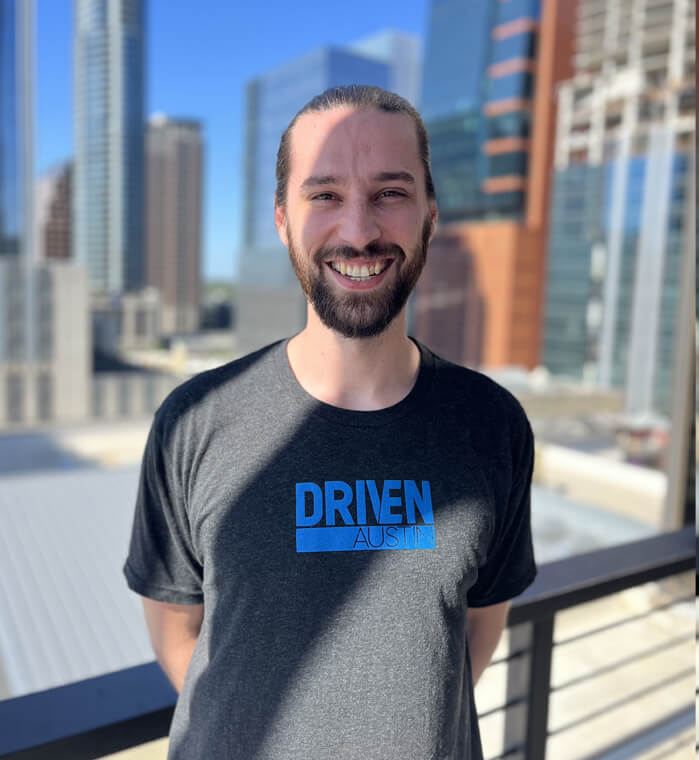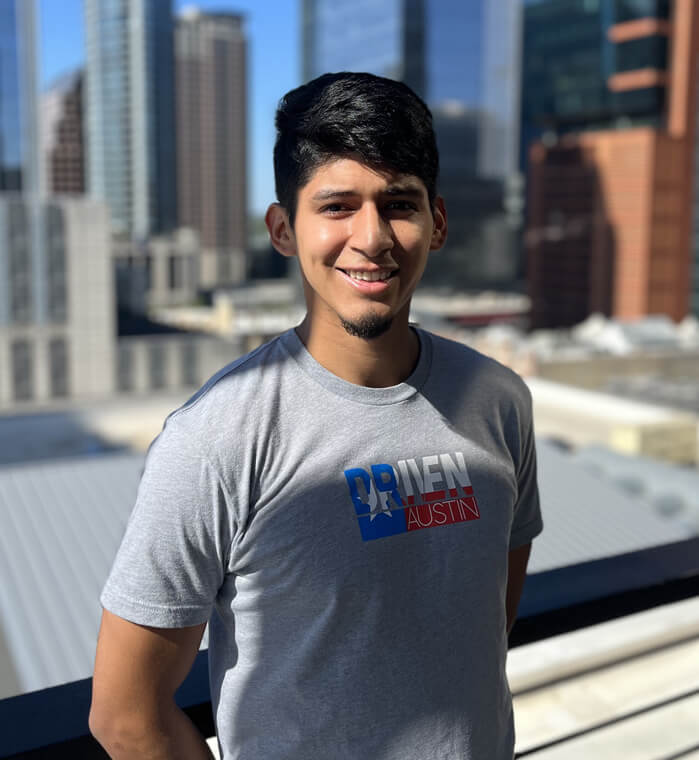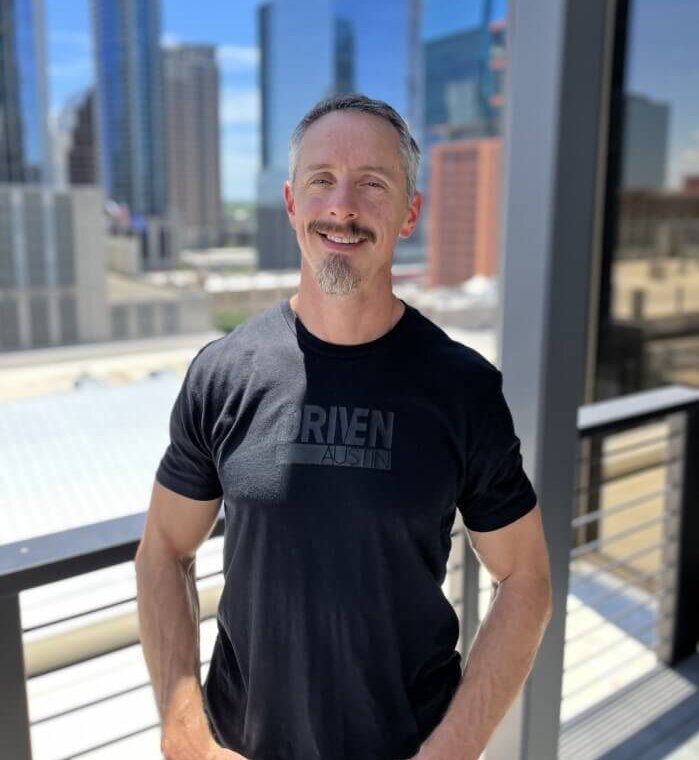Our Story
Driven opened in 2009 with the goal of facilitating the
best possible training environment for our clients.
Driven opened in downtown Austin in 2009 with the goal of being the anti-gym in every way imaginable. From the beginning, our priority was facilitating the best possible training environment for our clients. Rather than having gobs of members that we hoped didn’t show up, we wanted a smaller circle that we could fully invest our efforts on. Rather than acting as an assembly line where we churn large groups of strangers every 45 minutes we wanted a place where people we consider friends could come in to get a great workout that we could customize because we have history and know their strengths and limitations.
Over the years, we’ve added skills, services and equipment to continue to provide the best possible atmosphere for our clients. We have very high expectations of our coaches, and we are dedicated to their professional development as we’ll never stop trying to raise the bar and improve our services.
We pride ourselves in our extensive background and familiarity with the trends in the fields of fitness, rehabilitation, performance training, and nutrition and recognize that most people don’t fit neatly into one category. In fact, most of our clients utilize all of these services at one time or another regardless of why they came to us in the first place.
Our Team
-
Brett Lang, B.S., CSCS, NSCA Performance Specialist
Brett Lang, B.S., CSCS, NSCA Performance Specialist
Brett joined the Driven team as a Performance Specialist in 2023 with a B.S. in Kinesiology-Motor Behavior from Texas A&M University, is a Certified Personal Trainer and Certified Strength and Conditioning Specialist (CSCS) through the National Strength and Conditioning Association (NSCA). He also holds a Level 1 Performance Coaching certification through USA Weightlifting. Brett was born in San Antonio, Texas and has bounced around different parts of Texas since then.
Brett’s love for fitness started a little different than most. Being injured quite frequently throughout his youth sports career led to a lot of time on the training table with athletic trainers and with sports medicine doctors. The rehabilitation and physical therapy process really sparked the thirst for knowledge about the human body and how it works. He wanted to make an impact on others’ fitness and health before they experienced the same as him! Brett has gained experience from several different sources, starting off as a Personal Trainer at Gold’s Gym, then to private studio fitness in San Antonio. Before coming to Driven, Brett worked at D1 Training in Cedar Park, which mostly focused on middle and high school sports performance and development.
When Brett isn’t in the facility, he enjoys playing basketball, watching soccer and cooking up tasty and healthy meals!
-
Heidi Swailes, M.A., CPT, CAFS, CPPC, PPSC Performance Specialist
Heidi Swailes, M.A., CPT, CAFS, CPPC, PPSC Performance Specialist
Heidi joined the Driven team in 2021 as a Performance Specialist and Intuitive Eating Counselor.
Heidi is from the Midwest where she attended the University of Northern Iowa earning two degrees in Health Promotion: Fitness Management (B.A.) and Health Education (M.A.), and a certificate in Environmental Health while working as a fitness supervisor, peer health educator, and graduate assistant within their wellness and recreation department. Heidi then spent 11 years at the University of Iowa (UI) accumulating a vast array of diverse fitness, nutrition and wellness experience as a Fitness Specialist/Behavioral Health Consultant and Health and Human Physiology instructional-track faculty while also gaining five years of HIIT, running and kettlebell group and corporate fitness coaching experience as additional outlets for her energetic positivity. Heidi’s personal athletic background consists of mostly basketball and mid- and long-distance running, but don’t count her out of any sport or feat of physicality!
Heidi is a Certified Personal Trainer through the American College of Sports Medicine, is certified in Applied Functional Science through the Gray Institute, is a Certified Pain Free Performance Specialist, is a Certified Prenatal and Postnatal Coach, and has been a certified Intuitive Eating Counselor since 2011 helping individuals create a healthy relationship with food, exercise, mind and body and has over 15 years of experience in nutrition and wellness education and coaching. Heidi also completed kettlebell certification training through Dragon Door and taught progressive skill building kettlebell classes for four years.
Heidi is excited to come alongside the Driven community to improve movement quality and wellness for enhanced functioning, and empowers her clients to approach life with the mindset that there are no failures, only learning experiences, on the path to achieving their goals and sustaining their own unique healthy balance!
Heidi loves strength training, outdoor adventures, parks and trails, coffee, dancing, singing, humor, competition, culinary experimentation, and spending time with her two awesome kids Trey and Maybri, to name a few.
-
Steve Sagerstrom, B.S., CPT Performance Specialist
Steve Sagerstrom, B.S., CPT Performance Specialist
Steve joined the Driven team as a Performance Specialist in 2022 with a B.S. in Applied Health Sciences from Robert Morris University, is a Certified Personal Trainer through American Council on Exercise, and is working towards attaining his Certified Strength and Conditioning Specialist (CSCS) certification through the National Strength and Conditioning Association. Steve is Florida-born, Chicago-raised and loves to motivate, inspire and help all individuals and their fitness goals!
Steve grew a strong passion for fitness in the early stages of his athletic career. When he played college football he truly understood the importance, impact, and positive performance outcomes he gained from his trainers on and off the field. It was at this time he began an internship at Right Fit (now known as Base Fit Performance), a fitness facility that focused on exercise inclusivity for all ability levels. It allowed him to work with a wide spectrum of people, from D1 athletes to individuals with special needs, while accruing many valuable life lessons. It was here that he was offered a full-time position as a Trainer Specialist while also serving as a strength and conditioning coach for Brookfield High School football team in his free time. Over the years, Steve progressed to Manager of the Adult Human Performance facility at Base Fit where he embraced new challenges and opportunities for growth. The more Steve learned about the industry, the more he understood what he wanted to do within the field. He began searching for organizations that aligned with his interests and values and was fortunate enough to come across Driven! Driven brought all the things Steve was looking for into one facility: A place full of experts working together to create an unbelievable experience for all of their clients. Steve is excited to continue to grow and learn alongside the Driven community and to see what Austin and the rest of Texas has to offer!
When Steve is not at Driven, he’s likely chipping away at a form of self-improvement, enjoying running the Austin trails, playing golf, or trying new things!
-
Jonathan Rocha, B.S., ACSM-CPT Performance Specialist
Jonathan Rocha, B.S., ACSM-CPT Performance Specialist
Jonathan first joined Driven as an intern in the fall of 2022 and came back in summer of 2023 to assist in leading Driven’s group training efforts. He graduated from Texas State University with a B.S. in Exercise and Sports Science in Health and Fitness Management, and is a certified personal trainer through American College of Sports Medicine.
Jonathan is a born and raised Austinite who grew his passion for health and fitness playing sports growing up. In his free time, he loves to explore nature, find new dishes to meal prep, powerlift, jog around Town Lake, and is always in search of the best taco in town
-
Andy Twellman, M.ED., CSCS, FAFS Performance Specialist
Andy Twellman, M.ED., CSCS, FAFS Performance Specialist
With a Bachelor of Science degree in Exercise Science from Truman State University and a Master of Education in Kinesiology from the University of Texas, Andy has accrued over twenty years in the fitness field. His experience ranges from first time fitness novice clients to professional athletes and everyone in between. His unique coaching style allows him to adapt workouts and programs for each individual client.
Andy began his career with internships and volunteer positions in Physical Therapy clinics, at the prestigious Cooper Institute and Austin’s own University of Texas. He is a certified NG360° Golf Performance Specialist through Nike and the Gray Institute, a Certified Strength and Conditioning Specialist through the NSCA, a Master Fitness Specialist through the Cooper Institute and, after a year-long training endeavor alongside some of the most prominent physical therapists, trainers and physiotherapists at Gray Institute, he earned the title of Fellow of Applied Functional Science and was
invited to return as a facilitator for the class of 2009. His education and credentials have granted him access to some of the most innovative minds in fitness and continue to fuel his relentless fire to identify and master a better way of training. This motive is what led him to establish Driven Performance Training.
Andy lives in Cedar Park with his wife, Sally, and children, Drew, Quinn and Piper.
Internships
Our internship is the lifeblood of Driven and the primary
process through which we recruit and train our next generation
of outstanding coaches.
But in reality, it’s much more than that. Albert Einstein said “If you can’t explain it simply, you don’t understand it well enough“. We fully believe that to be true, and the internship process constantly challenges us to make the complex simple.
The internship is a minimum of 20 hours/week and the curriculum consists of several key components:
- Video Lectures – We want to maximize the times when we are all together, so we’ve recorded our lectures so that you can watch them on your own time and bring questions to our group discussions.
- Group Discussions – We’ll dedicate 1-2 hours per week to reviewing the previous week’s lecture materials and answering questions, which we’ll expect you to have a lot of.
- Directed Research/writing – We believe that communicating via the written word is a great way to improve your understanding of training. You’ll receive multiple writing assignments over the course of the semester, some of your choosing, some based on topics we assign to you.
- Assistant Coaching – All of the knowledge in the world isn’t going to help if you can’t coach, so you’ll be expected to help out with coaching so that you can put this knowledge into practice.
- Experimenting – Odds are you’ll be learning many new things related to training so we fully expect that you’ll use our facility during down hours to try some of the things you’re learning.
Here's a sneak peak at the curriculum:
- A primer on driven – organization, people, services, strategy
- Introduction to forces: gravity, ground reaction, and momentum
- Training principles – our strategic foundation
- Anatomy review – joint structure and triplanar function
- Biomechanical basis of movement
- Nomenclature – Position, Driver, Action, Triangulation, Load, Speed, Reps, Range, etc.
- Evaluating current trends in fitness and training
- Spotting 101 – safety
- Influence of starting position on joint biomechanics
- Adaptation – force as the language of cells
- Evaluation part 1 – the client interview
- Evaluation part 2 – posture
- Evaluation part 3 – gait analysis
- Evaluation part 4 – foot, ankle, and hip
- Evaluation part 5 – spine, scapula, shoulder
- Programming part 1 – creating a strategy
- Programming part 2 – the test is the exercise (and the exercise is the test)
- Programming part 3 – basic workout template
- Programming part 4 – progressions and regressions
- Programming part 5 – designing group training workouts
- Specific training techniques – multiple lectures covering a variety of specialized exercises
- Sport breakdown – identifying key trainable variables
If you’re interested in learning more about making fitness and performance a career, Contact Us Today.





